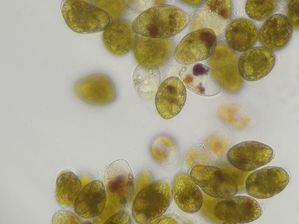– Perception, Communication –
We were trying to imagine the sensations of plankton through our own senses。
o OOo。。
We asked: Do they have a heart? Do they have a brain? Can they feel?
o OOo。。
。。Oo。。
Human imagination is always an attempt to use our senses as metaphors.
At first, I felt powerless because I could not find a way to “communicate” with plankton. Then I began to ask: what is communication?
✺
For me, it is the imagined possibility of establishing an equal relationship, an exchange of information, with another being. Yet I realize that even with humans, I cannot truly imagine what an equal exchange looks like. Perhaps it is an illusion to think I could ever communicate with plankton. We are fundamentally different. Beyond looking and touching, I can do nothing. And even those verbs are limited by the narrow spectrum of human senses.
When we looked at the flower-like “eye” of the daphnia, we wondered: what is it seeing? why does it need to see? Eventually, science offered an answer: it is a photosensitive organ. This floral sphere drifts inside its skin-covered liquid body. Light passes through its almost transparent membrane, reaching the “flower,” which tells the daphnia whether it is time to rise to the surface.
✺✺✺
✺
Our senses give us perspective, but they also impose hierarchy, value, projection. From a few simple inputs, we weave elaborate associations and begin to imagine that we can claim what never belonged to us in the first place.
✺
Perhaps communication is nothing more than this: the attempt to grasp what does not belong to us — the feelings, thoughts, and experiences of others. From fragments, from glances, we believe we can obtain them.
The verb I find most fitting is to feel. It does not demand a specific organ; it suggests a diffuse contact. But here human advantage returns: to feel another organism means to touch it with emotion, to intrude into its private domain — a space that communication can never truly penetrate. OOo。。We may see the same thing, hear the same thing, but we can never feel the same.
– Opacity –
I love the moments when I ask, why is this organism like this?
and no one
not experts
not AI
can give me a definite answer.
oOOoo o。。o
Because such an answer would mean analysis, dissection, the presumption that the organism can be fully understood. Whether it is because plankton are too small to study in detail, or because current technology is insufficient, or because some mysteries may remain forever unknowable — these nearly transparent beings still preserve their opacity.
“We clamor for the right to opacity for everyone.”
— Édouard Glissant, Poetics of Relation, 1990
I can see them: I can see their organs, their eating, digestion, reproduction, excretion. I could watch their entire life. And yet I cannot see them. They refuse communication; they remain inaccessible.
And I am powerless.
– Liquid Modernity –
Liquids flow easily. They may stream, spill, splash, cascade, seep, surge, spurt, drip, ooze, or trickle — endlessly varied. Unlike solids, their flow is hard to resist. Confronting obstacles, they curve around or dissolve them. Meeting still objects, they pierce a gap, infiltrating as they advance. Liquids emerge unscathed, while solids, when exposed to them, are altered — soaked, permeated, undone.
— Zygmunt Bauman, Liquid Modernity
In liquid modernity, Bauman imagines society itself as fluid. But are plankton “free” in the water? Some even grow appendages to swim actively. Phytoplankton, through photosynthesis, produce more than half of the world’s oxygen, ensuring their survival despite their rootless physiology.
– Drifting –
Plankton comes from the Greek planktos, meaning “drifter.”
~~ fúúúú yóóóóóóóóóóóóu ~~~
In Chinese, 浮游 (fúyóu) combines float and travel. They have no fixed habitat, no deep roots; their lives are brief and dependent on the movements of their environment. Drifting is a tension between passivity and agency: they are carried by currents, yet they can also move in small ways — like the colony of Bacillaria, sliding up and down in synchrony to form local order.
~~ fúúúú ~~~~~~~~~
~~~~~~~~~úúú~~~~
When I imagine roots, I imagine something outside the body. But in many aquatic plants, we do not see roots. From the smallest phytoplankton and algae to larger duckweed, these beings often exist without visible anchorage. They cling together temporarily, drifting in transient constellations, only to separate and recombine again.
A drifting body. A migrating identity. A provisional collectivity.
This is a process of a project. It may be a grand endeavor, or perhaps just a beautiful wish. It may gradually take shape over the coming months. (CAREFUL! A mechanical plankton entity with “sensory” will appear!)
Here lies humanity's first associations, fantasies, and dreams about plankton. In the current research, understanding, and critique of humans, what wondrous echoes do plankton bring forth?







